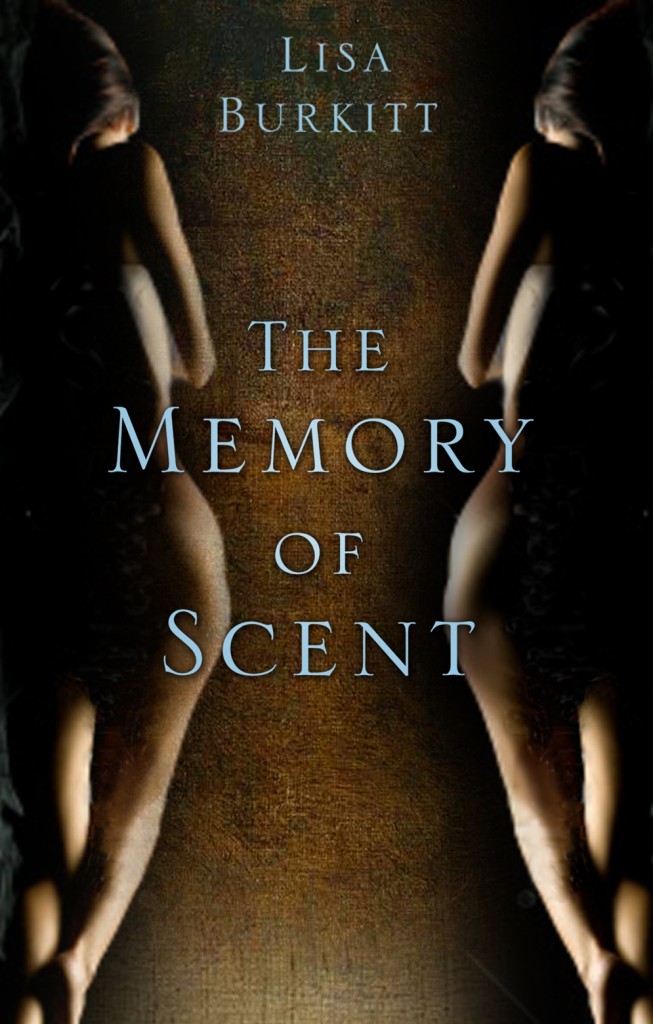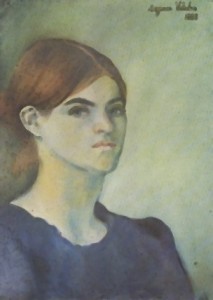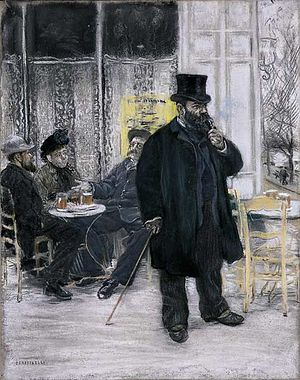 This art-based historical mystery The Memory of Scent by Lisa Burkitt is set 1883 Paris, France. It is a story of two French women, Fleur and Babette, both artist models, and how their lives diverge when the painter they both pose for is found dead. Fleur lives her life on the fringes of the Impressionist movement listening in on artist conversations of Degas, Renoir, Monet and Toulouse Lautrec, spending time in the turpentine fumed artist studio, and haunts of Paris’ nightlife where bohemians convene. Beautiful Babette’s lucky star falls after the death of the artist as she is subsequently thrust into the underbelly of Paris and into dark corners and streets. This novel focuses on the senses and upon the deep reflections of protagonist Fleur and Babette, revealing nineteenth century Paris life and the art scene in all its various colorful and not so colorful shades. Scent, memory, love, and loss are explored, and where it appears the ties which hold people together can also tear people apart.
This art-based historical mystery The Memory of Scent by Lisa Burkitt is set 1883 Paris, France. It is a story of two French women, Fleur and Babette, both artist models, and how their lives diverge when the painter they both pose for is found dead. Fleur lives her life on the fringes of the Impressionist movement listening in on artist conversations of Degas, Renoir, Monet and Toulouse Lautrec, spending time in the turpentine fumed artist studio, and haunts of Paris’ nightlife where bohemians convene. Beautiful Babette’s lucky star falls after the death of the artist as she is subsequently thrust into the underbelly of Paris and into dark corners and streets. This novel focuses on the senses and upon the deep reflections of protagonist Fleur and Babette, revealing nineteenth century Paris life and the art scene in all its various colorful and not so colorful shades. Scent, memory, love, and loss are explored, and where it appears the ties which hold people together can also tear people apart.
Two models, two contary lives…”Patchouli is Paris. Lavender hinted at warm bread and plump maternal women.” ~ The Memory of Scent
Stephanie Renee dos Santos: Your main protagonist Fleur is an artist model and how does she exemplify models of the day? From what social classes were most models from and how were they regarded socially in 1883?
Lisa Burkitt: Fleur was typical of the type of young working class, Montmartre dwelling model who would have moved from job to job. Modelling was not a regular source of income – though when they were paid, they could make what was considered good money, sometimes ten francs a day. Some models would find work in Institutional and academic settings, but artists would often look to hire them from the ‘model markets’ one of which was on the Place Pigalle. Young girls would be accosted by artists in the street or in cafes and asked to pose, which of course was an income boost, but in many cases, there was a thin and fluid line between modelling and prostitution. Degas and Toulouse-Lautrec chose prostitutes as models and also painted in brothels. Modelling was often viewed more critically than prostitution. Girls initially prized as models, were rarely used as they began to age and this often became another route to prostitution.
SRDS: What compelled you to include art and artist in your historical novel?
LB: About 25 years ago, I had this idea to write about a female model who wanted to be an artist. I was always interested in the Impressionist era and knew that this would be my setting. I took myself off to the library (this was pre internet days!) and cross-referenced the various artists of the era to get a sense of the life of a model…and this one name kept popping up; ‘Suzanne Valadon’. She sat for Puvis de Chavannes, Renoir, Toulouse-Lautrec and many others, and it can be assumed also became lover to several of the artists. She was an instinctively talented artist herself. I was fascinated to find out that this woman in my head actually existed in real life and I became intrigued by her. What did I do about it? Absolutely nothing. I carried on my day job and then several years later, I came across June Rose’s fascinating biography; Suzanne Valadon; The Mistress of Montmartre.
The desire to write a novel stayed with me and when I decided to just get on with it, I knew I had to keep Suzanne involved somehow, so instead wrote her up as a secondary character in the book using available facts of her life.
SRDS: What drew you to your specific visual art medium, artwork and/or artist?
LB: In choosing to make The Memory of Scent a strong character study of the Suzanne Valadon and her contemporaries of the day, some real, some fictionalised, I have used a very specific timeline, that of the year 1883. I have concentrated events within this timeline and referenced actual paintings that would have been created within it. (pg 88. ‘I stop by Maria’s on my way home and she beckons me into her cramped one-room apartment. She wipes her hands on an old cloth and steps back from the easel. Staring defiantly at me is a self-portrait in pastel that she has been working on. This chin is slightly raised, almost scornfully; the hair severely parted in the middle and tucked behind the ears; the neckline of the dress is conservative and prim. The general effect lacked even a hint of flattery. It was a powerful drawing, bold and unforgiving.’)
SRDS: What unique historical objects and/or documents inspired the story?
LB: Because The Memory of Scent is embedded in such a specific year, several sources were available to me to draw events as authentically as possible. ‘The Timetables of History’ by Bernard Grun is a very useful reference volume as it maps out what is happening ‘simultaneously’ in the world of science & technology, politics, philosophy and religion, arts and musical happenings within a given year. This was how I knew to have the young courtesan, Lily, be taken to the opening night at the Opéra Comique of Léo Delibes, Lakmé which that night, starred the American singer, Marie van Zandt.
Archived newspapers are always a useful tool to set the tone of an era and I find that advertisements are very revealing as to the preoccupations of the day, so I have Fleur distractedly looking at an advertisement for things like ‘Curling Fluid’ and ‘Bloom of Roses for giving beauty to the lips and cheeks.’
The Memory of Scent has been described as a novel of the senses and food was always to be a part of the story – both the lack of it and by contrast, the indulgence of it through the gourmand character of Walrus. I was hugely informed by the luscious approach to food of the 19th century food critic, Grimod de La Reynière.
SRDS: Is there an art history lesson you’ve tried to highlight within the novel?
LB: I think I have always been fascinated by the lives of artists and how their lifestyles inform their art. I am always curious about that balance between bravery and self-absorption. My preference is to read biographies on artists and then to place their art within that. I like to try to visualise what they were doing when a particular work was created and who was in their circle that may have had any influence on their choices and decisions. I can bring nothing new to the table when it comes to writing about the Impressionist era so it was really just a question of trying to immerse myself in the sounds and smells of 1800s Paris, to pull up a chair at the Bonne Franquette bar in Montmartre and down some absinthe.
SRDS: What do you think readers can gain by reading stories with art tie- ins?
LB: Sometimes the art world can be too precious. It can have its own language, vocabulary, terminology, and fraternity. It can be divisive – the initiated versus the uninitiated. Art is organic and stories with art tie-ins give a more honest insight into that reality. They lift the corners and do not restrict us to simply being ticket-buying spectators forced to stand behind the rope.
SRDS: What fascinating information did you uncover while researching but were unable to incorporate into the book, but can share here?
LB: When I sent one of my girls to prison…that became an eye-opener! There was a lot about prison life for women that I could have gone off on a tangent on. Lesbianism was a given; the problems of menstruation were handled with little care or concern (straw was swept in on the floor for the women’s use); syphillitic women were identified by their headgear. A whole microcosm of humanity existed on the fringes.
SRDS: Any further thoughts on art in fiction you’d like to expand on?
LB: Art in fiction is an endless vein to mine. There’s the work itself, how it came about, who brought it into existence, what became of it. It spans genre’s (thrillers/historical/romance/drama/literary). Art can act as a minor plot point in fiction or as its central theme. And the best thing about art in fiction is that it tends to inspire further curiosity. It often piques your interest enough to check into something further or more closely.
SRDS: Are you working on a new historical novel with an art tie-in? If so, will you share a little with us about your next release?
LB: I am currently finishing a crime thriller, Anatomy of a Jump which is set in modern day New York with no art tie-in (other than a few visits to the Museum of Modern Art!) but am constantly researching female protagonists within the art world that I can build my next novel around. It is a genre I will definitely return to.
 About the author: Lisa Burkitt worked in the media for eighteen years in both print and broadcast journalism. She also wrote for several years as a weekly columnist with the Johnston Press group. She is now a fulltime writer and artist based in Co. Donegal, Ireland. Lisa has been anthologised in ‘Best Paris Stories’ and The Memory of Scent is her debut novel.
About the author: Lisa Burkitt worked in the media for eighteen years in both print and broadcast journalism. She also wrote for several years as a weekly columnist with the Johnston Press group. She is now a fulltime writer and artist based in Co. Donegal, Ireland. Lisa has been anthologised in ‘Best Paris Stories’ and The Memory of Scent is her debut novel.
To buy: The Memory of Scent
Join us here May 30th for an interview with Lisa Barr, author of Fugitive Colors!
Interview posting schedule:
2014: August 30th Susan Vreeland, Lisette’s List (new release), September 27th Anne Girard, Madame Picasso (new release),October 25th Yves Fey, Floats the Dark Shadow, November 29th Mary F. Burns, The Spoils of Avalon (new release), December 27th Kelly Jones, The Woman Who Heard Color
2015: January 31st Heather Webb, Rodin’s Lover (new release), February 28th Alyson Richman, The Mask Carver’s Son, March 28th Maureen Gibbon, Paris Red (new release), April 11th M.J Rose, The Witch of Painted Sorrows (new release), April 25th Lisa Brukitt, The Memory of Scent, May 30th Lisa Barr, Fugitive Colors, June 27th Lynn Cullen, The Creation of Eve, July 25th Andromeda Romano-Lax, The Detour, August 29th Frederick Andresen,The Lady with an Ostrich Feather Fan, September 26 Nancy Bilyeau, The Tapestry (new release), October 31st Laura Morelli The Gondola Maker
Join Facebook group “Love of Arts in Fiction”!




This is great. Learning of the “life” of the characters, their birth and development by the author, is interesting and a learning experience,. Thanks.
It’s also great to be able to talk about the characters Frederick. They become so real, almost like friends that you want other people to know about! Lisa
The novel sounds wonderful, and it was fascinating to read about the long ago roots and how the focus evolved. Thank you both!
The long ago roots should not have been so long ago Jeannine! The curse of procrastination. But then if something stays with you for that long, you have to go with it. Lisa